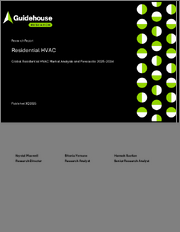
세계 주거용 HVAC 시장은 에너지 효율적이고 지속가능한 기후 적응형 솔루션에 대한 수요로 인해 2034년까지 안정적인 성장이 예상됩니다. 단독주택 및 공동주택용 용광로, 보일러, 히트 펌프, 에어컨 등의 장비를 포함한 이 시장은 지역 동향에 따라 형성됩니다. 현재 아시아태평양이 룸 에어컨 보급과 히트 펌프에 대한 관심 증가로 수익 측면에서 선두를 달리고 있지만, 강력한 탈탄소 정책과 보일러에서 전기화 시스템으로의 빠른 전환으로 유럽이 2034년까지 아시아태평양을 추월할 것으로 예상됩니다. 북미는 중앙 에어컨과 히트 펌프에서 견조한 성장세를 유지하고, 라틴아메리카와 중동 및 아프리카는 인프라와 가격의 제약으로 인해 완만한 성장이 예상됩니다. 모든 지역에서 공통적으로 정부의 인센티브, 실내 공기질에 대한 관심, 기후 적응의 필요성이 시장 확대를 가속화하고 있습니다.
주요 권고사항으로는 히트 펌프 및 에너지 효율이 높은 솔루션의 혁신을 우선시하고 세계 탈탄소화 추세에 맞춰야 한다는 점을 꼽을 수 있습니다. 정책 입안자들은 인센티브와 최신 법규를 통해 채택을 지원해야 하며, 주택 소유자는 고효율 시스템을 선택함으로써 장기적으로 비용 절감의 혜택을 누릴 수 있습니다. 세계 주거용 HVAC 시장 규모는 2025년 1,389억 달러에서 2034년 1,805억 달러로 CAGR 3.0%로 성장할 것으로 예상됩니다.
세계의 주거용 HVAC 시장을 조사했으며, 시장 개요, 시장 촉진요인과 과제, 경쟁 상황, 시장 규모 추정 및 예측, 건설 유형·건물 유형·기기·지역별 분석, 시장 진입 사업자에 대한 제안 등의 정보를 정리하여 전해드립니다.
The global residential HVAC market is set for steady growth through 2034, propelled by demand for energy efficient, sustainable, and climate-adaptive solutions. Including equipment such as furnaces, boilers, heat pumps, and air conditioning units for single-family and multifamily homes, the market's trajectory is shaped by regional trends. Asia-Pacific currently leads in revenue, driven by room A/C adoption and rising interest in heat pumps, while Europe is expected to overtake it by 2034 due to strong decarbonization policies and a rapid shift from boilers to electrified systems. North America remains robust for central A/C and heat pumps, and Latin America and the Middle East & Africa are forecast to grow more gradually, limited by infrastructure and affordability. Across all regions, government incentives, awareness of indoor air quality, and climate adaptation needs are accelerating expansion.
In this report, Guidehouse Research analyzes the market using a bottom-up modeling approach, segmenting by region, building type, construction type, and equipment. The report draws on interviews with industry leaders and secondary research, focusing on equipment revenue from 2025 to 2034. It highlights the impact of regulations, innovation, and consumer trends, while addressing barriers such as high upfront costs, supply chain volatility, and skilled labor shortages. The competitive landscape is mapped through profiles of major manufacturers, mergers and acquisitions, and pricing strategies.
Key recommendations include prioritizing innovation in heat pumps and energy efficient solutions to align with global decarbonization trends. Policymakers should support adoption through incentives and modernized codes, while homeowners can benefit from long-term savings by choosing high-efficiency systems. Notably, the global residential HVAC market is projected to grow from US$138.9 billion in 2025 to US$180.5 billion by 2034, a compound annual growth rate of 3.0%.